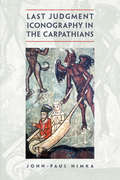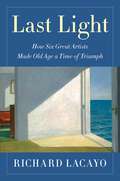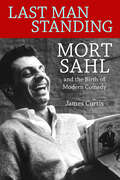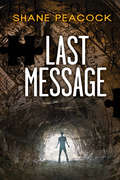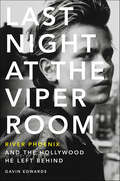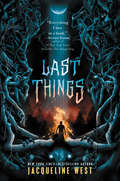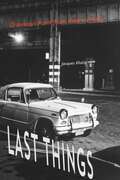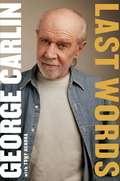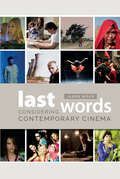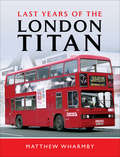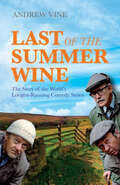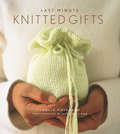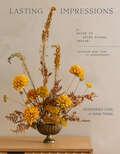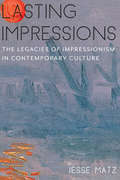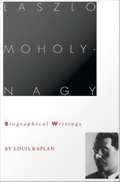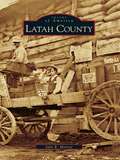- Table View
- List View
Last Judgment Iconography in the Carpathians
by John-Paul HimkaFew subjects in Christianity have inspired artists as much as the last judgment. Last Judgment Iconography in the Carpathians examines images of the last judgment from the fifteenth century to the present in the Carpathian mountain region of Ukraine, Poland, Slovakia, and Romania, as a way to consider history free from the traditional frameworks and narratives of nations. Over ten years, John-Paul Himka studied last-judgment images throughout the Carpathians and found a distinctive and transnational blending of Gothic, Byzantine, and Novgorodian art in the region.Piecing together the story of how these images were produced and how they developed, Himka traces their origins on linden boards and their evolution on canvas and church walls. Tracing their origins with monks, he follows these images' increased popularity as they were commissioned by peasants and shepherds whose tastes so shocked bishops that they ordered the destruction of depictions of sexual themes and grotesque forms of torture. A richly illustrated and detailed account of history through a style of art, Last Judgment Iconography in the Carpathians will find a receptive audience with art historians, religious scholars, and slavists.
Last Light: How Six Great Artists Made Old Age a Time of Triumph
by Richard LacayoOne of the nation&’s top art critics shows how six great artists made old age a time of triumph by producing some of the greatest work of their long careers—and, in some cases, changing the course of art history.Ordinarily, we think of young artists as the bomb throwers. Monet and Renoir were still in their twenties when they embarked on what would soon be called Impressionism, as were Picasso and Braque when they ventured into Cubism. But your sixties and the decades that follow can be no less liberating if they too bring the confidence to attempt new things. Young artists may experiment because they have nothing to lose; older ones because they have nothing to fear. With their legacies secure, they&’re free to reinvent themselves…sometimes with revolutionary results. Titian&’s late style offered a way for pigment itself—not just the things it depicted—to express feelings on the canvas, foreshadowing Rubens, Frans Hals, 19th-century Impressionists, and 20th-century Expressionists. Goya&’s late work enlarged the psychological territory that artists could enter. Monet&’s late waterlily paintings were eventually recognized as prophetic for the centerless, diaphanous space developed after World War II by abstract expressionists like Jackson Pollock and Phillip Guston. In his seventies, Matisse began to produce some of the most joyful art of the 20th century, especially his famous cutouts that brought an ancient craft into the realm of High Modernism. Hopper, the ultimate realist, used old age on occasion to depart into the surreal. And Nevelson, the patron saint of late bloomers, pioneered a new kind of sculpture: wall-sized wooden assemblages made from odds and ends she scavenged from the streets of Manhattan. Though these six artists differed in many respects, they shared one thing: a determination to go on creating, driven not by the bounding energies of youth but by the ticking clock that would inspire them to produce some of their greatest masterpieces.
Last Man Standing: Mort Sahl and the Birth of Modern Comedy
by James CurtisA Times Literary Supplement 2017 Book of the YearOn December 22, 1953, Mort Sahl (1927–2021) took the stage at San Francisco's hungry i and changed comedy forever. Before him, standup was about everything but hard news and politics. In his wake, a new generation of smart comics emerged—Shelley Berman, Mike Nichols and Elaine May, Lenny Bruce, Bob Newhart, Dick Gregory, Woody Allen, and the Smothers Brothers, among others. He opened up jazz-inflected satire to a loose network of clubs, cut the first modern comedy album, and appeared on the cover of Time surrounded by caricatures of some of his frequent targets such as Dwight Eisenhower, Richard Nixon, Adlai Stevenson, and John F. Kennedy. Through the extraordinary details of Sahl's life, author James Curtis deftly illustrates why Sahl was dubbed by Steve Allen as “the only real political philosopher we have in modern comedy.”Sahl came on the scene the same year Eisenhower and Nixon entered the White House, the year Playboy first hit the nation's newsstands. Clad in an open collar and pullover sweater, he adopted the persona of a graduate student ruminating on current events. “It was like nothing I'd ever seen,” said Woody Allen, “and I've never seen anything like it after.” Sahl was billed, variously, as the Nation's Conscience, America's Only Working Philosopher, and, most tellingly, the Next President of the United States. Yet he was also a satirist so savage the editors of Time once dubbed him “Will Rogers with fangs.”Here, for the first time, is the whole story of Mort Sahl, America's iconoclastic father of modern standup comedy. Written with Sahl's full cooperation and the participation of many of his friends and contemporaries, it delves deeply into the influences that shaped him, the heady times in which he soared, and the depths to which he fell during the turbulent sixties when he took on the Warren Commission and nearly paid for it with his career.
Last Message (Seven (the Series) #3)
by Shane PeacockAdam has a good life in Buffalo: great parents, a cute girlfriend, adequate grades. He's not the best at anything, but he's not the worst either. He secretly lusts after Vanessa, the hottest girl in school, and when his dead grandfather's will stipulates that he go on a mission to France, Adam figures he might just have a chance to impress Vanessa and change his life from good to great. When he gets to France, he discovers he has not one but three near-impossible tasks before him. He also discovers a dark and shameful episode from his grandfather's past, something Adam is supposed to make amends for. But how can he do that when he barely speaks the language and his tasks become more and more dangerous? Despite the odds, Adam finds a way to fulfill his grandfather's wishes and, in the process, become worthy of bearing his name. Adam's adventures start in Separated, part of The Seven Prequels and continue in Double You, part of The Seven Sequels.
Last Night at the Viper Room: River Phoenix and the Hollywood He Left Behind
by Gavin EdwardsA biography elucidating the Academy Award–nominee’s meteoric rise, his tragic end, and his legacy.At the dawn of the 1990s, a new crew of leading men—Johnny Depp, Nicolas Cage, Keanu Reeves, and Brad Pitt—was rocketing toward stardom. River Phoenix, however, stood in front of the pack. But behind Phoenix’s talent and beautiful public face was a young man who had been raised in a cult by nonconformist parents, who was burdened with supporting his family from a young age, and who eventually succumbed to addiction, dying of an overdose in front of the Viper Room, West Hollywood’s storied club, at twenty-three.Last Night at the Viper Room is part biography, part cultural history of the 1990s, and part celebration of a Hollywood icon gone too soon. Full of interviews from his fellow actors, directors, friends, and family, this book shows the role River Phoenix played in creating the place of the actor in our modern culture and the impact his work still makes today.
Last Pen Standing (Stationery Shop Mystery #1)
by Vivian ConroyWill this paper trail run cold?As the new co-owner of Tundish Montana's stationery shop WANTED, Delta Douglas knows how to organize a killer crafting event. Creativity and cardstock are all she needs to move one step closer to her ultimate dream: developing her own line of crafting products. But on the night of the workshop, at the swanky hotel venue, glitter isn't the only thing found sprawled on the floor. A hotel guest is discovered dead in the bar, and amid the confusion, Delta's best friend is suspected of the crime.Enlisting the help of her Paper Posse and Spud, her canine sidekick, Delta dives into the investigation. But with many high-powered suspects on the line, Delta soon realizes her sleuthing may come with deadly consequences.
Last Seen Alone: The heartpounding new thriller you won't be able to put down!
by Laura GriffinWith her signature breathless pacing and suspenseful twists and turns, 'Laura Griffin never fails to put me on the edge of my seat' (USA TODAY).If you love Karen Rose, Melinda Leigh and Lisa Gardner, you'll be gripped by Laura Griffin!'I love smart, sophisticated, fast-moving romantic thrillers and Laura Griffin writes them brilliantly' Jayne Ann Krentz'A pulse-pounding romantic thriller' Publishers Weekly.............................................................................................A missing victim. A merciless killer.Up-and-coming attorney Leigh Larson fights for victims of sexual extortion, harassment, and online abuse. She's laser-focused on her career and not afraid to go after the sleaziest targets to get payback for her clients. Austin homicide detective Brandon Reynolds is no stranger to midnight callouts, but his investigation of an abandoned car on a desolate road reveals an unusual crime scene. A pool of blood in the nearby woods suggests a brutal homicide. But where is the victim? The vehicle is registered to twenty-six-year-old Vanessa Adams, yet all Brandon finds inside is a smear of blood and a business card for Leigh Larson, attorney-at-law. Vanessa had hired Leigh just before her disappearance, but Leigh has no leads on who could have wanted her dead. Faced with bewildering evidence and shocking twists, Leigh and Brandon must work against the clock to chase down a ruthless criminal who is out for vengeance..............................................................................................Raves for Laura Griffin:'Desperate Girls is a nail-biting read from the very first page to the final, shocking twist. I could not put this book down' Melinda Leigh'Griffin pulls out all the stops in a phenomenal twist ending that will leave readers stunned' Publishers Weekly
Last Things
by Jacqueline West"Everything I love in a book."—Victoria Schwab, author of #1 New York Times bestseller This Savage Song“The kind of taut, atmospheric thriller that gets your heart racing and sets your imagination on fire. Sensational.”—Claire Legrand, New York Times-bestselling author of FurybornNew York Times–bestselling author Jacqueline West captivates readers with a dark, hypnotic story about the cost of talent—and the evil that lurks just out of sight. Fans of Holly Black and Victoria Schwab will be mesmerized by this gorgeous, magnetic novel.High school senior Anders Thorson is unusually gifted. His band, Last Things, is legendary in their northern Minnesota hometown. With guitar skills that would amaze even if he weren’t only eighteen, Anders is the focus of head-turning admiration. And Thea Malcom, a newcomer to the insular town, is one of his admirers. Thea seems to turn up everywhere Anders goes: gigs at the local coffeehouse, guitar lessons, even in the woods near Anders’s home.When strange things start happening to Anders, blame immediately falls on Thea. But is she trying to hurt him? Or save him? Can he trust a girl who doesn’t seem to know the difference between dreams and reality? And how much are they both willing to sacrifice to get what they want? Told from Anders’s and Thea’s dual points of view, this exquisitely crafted novel is full of unexpected twists and is for fans of Holly Black’s The Darkest Part of the Forest and Melissa Albert’s The Hazel Wood.
Last Things: Disastrous Form from Kant to Hujar (Lit Z)
by Jacques KhalipThe arrival of the Anthropocene brings the suggestion that we are only now beginning to speculate on an inhuman world that is not for us, only now confronting fears and anxieties of ecological, political, social, and philosophical extinction. While pointing out that reflections on disaster were not foreign to what we historically call romanticism, Last Things pushes romantic thought toward an altogether new way of conceiving the “end of things,” one that treats lastness as neither privation nor conclusion. Through quieter, non-emphatic modes of thinking the end of human thought, Khalip explores lastness as what marks the limits of our life and world. Reading the fate of romanticism—and romantic studies—within the key of the last, Khalip refuses to elegize or celebrate our ends, instead positing romanticism as a negative force that exceeds theories, narratives, and figures of survival and sustainability. Each chapter explores a range of romantic and contemporary materials: poetry by John Clare, Emily Dickinson, John Keats, Percy Shelley, and William Wordsworth; philosophical texts by William Godwin, David Hume, Immanuel Kant, and Jean-Jacques Rousseau; paintings by Hubert Robert, Caspar David Friedrich, and Paterson Ewen; installations by Tatsuo Miyajima and James Turrell; and photography by John Dugdale, Peter Hujar, and Joanna Kane. Shuttling between temporalities, Last Things undertakes an original reorganization of romantic thought for contemporary culture. It examines an archive on the side of disappearance, perishing, the inhuman, and lastness.
Last Word
by Josh GrossMany of the movies we love are best captured in their final scenes, from the Tracy-Hepburn love fest in Adam's Rib to the image of Dorothy back in her bed in Kansas. Turning the pages of this irresistible little book is like reliving the final moments of America's favorite movies, including:The African QueenCitizen KaneE.T. - The Extra-TerrestrialThe GodfatherGone With the WindIt's a Wonderful LifeKing KongThe Maltese FalconNorth by NorthwestThe Philadelphia StoryRosemary's BabyShaneStar WardsSunset BoulevardWest Side StoryThe Wizard of Oz
Last Words
by George Carlin Tony HendraThis ebook features added multimedia content: an interview with George Carlin's daughter Kelly about life with her dad and a tribute video with interviews with Susie Essman, Michael Ian Black, Richard Belzer, George Wendt, and Jeffrey Ross, who talk about Carlin's incredible ability to make people laugh.Last Words is pure, unapologetic, hilarious George Carlin. With 19 appearances on the Johnny Carson show, 13 HBO specials, 5 Grammys, a critical Supreme Court battle over censorship, and countless appearances on the international comedy circuit, George Carlin saw it all and made fun of most of it. Blending his signature acerbic humor with never before told stories from his own life, this book is part comedy routine, part memoir, and all original. His journey to stardom began in the rough and tumble neighborhoods of New York in the 1950's, where class and culture wars planted the seeds for some of his earliest material including the infamous Seven Dirty Words sketch. Carlin describes his major influences as an up and coming comic, talking about the origins of some of his most famous stand up routines. The people he encountered on his rise to stardom reads like a Who's Who of 1970's celebrity, from Lenny Bruce who took him under his wing to Hugh Hefner who gave him his first big shot. Carlin spares no details as he describes his life and career. He discusses his own battle with substance abuse, his turbulent relationships with the women in his life, and the politics that informed so much of his stand up. From the high points on stage to low points in the hospital, Last Words is George Carlin's life told with the brash, unblinking honesty that defined his comedy and made him one of the best loved comedians in history.
Last Words
by Jason WoodLast Words features extensive interviews with Christopher Nolan, Harmony Korine, Charlie Kaufmann, Nicolas Winding Refn, Wim Wenders, Michael Winterbottom, Christian Petzhold, and many others. Each interview is preceded by an overview of the director's work, and the volume's authoritative introductory essay explores the value of these directors and why they are rarely given an appropriate platform to discuss their craft.
Last Words: Considering Contemporary Cinema
by Jason WoodLast Words features extensive interviews with contemporary directors and overviews of the directors' work
Last Words: Considering Contemporary Cinema
by Jason WoodLast Words features extensive interviews with Christopher Nolan, Harmony Korine, Charlie Kaufmann, Nicolas Winding Refn, Wim Wenders, Michael Winterbottom, Christian Petzhold, and many others. Each interview is preceded by an overview of the director's work, and the volume's authoritative introductory essay explores the value of these directors and why they are rarely given an appropriate platform to discuss their craft.
Last Years of the London Titan
by Matthew WharmbyThe author of The London Bendy Bus memorializes the end of the Leyland Titan era in &“a must for all London bus fans of the 1980s&” (West Somerset Railway Association). Already depleted by withdrawals in the London Buses Ltd era, the Leyland Titan fleet of T class was divided upon privatization between three new companies: London Central, Stagecoach East London and Stagecoach Selkent. Together with a host of smaller companies operating secondhand acquisitions, the Titans&’ declining years between 1998 and 2003 are explored in this pictorial account that encompasses both standard day-to-day routes, emergency deployments and rail replacement services. Only small numbers remained to usher out the type altogether at the end of 2005, when step-entrance double-deckers as a whole were banished from the capital. &“[A] magnificent portrait of the time through an interesting collection of images.&” —Miniaturas JM
Last of the Summer Wine: The Story of the World's Longest-Running Comedy Series
by Andrew VineAn insider’s look at story behind the longest running situation comedy in British television history.Quite simply, Last of the Summer Wine is the longest-running comedy programme in the world. It premiered thirty-seven years ago, in 1973, and, after thirty-one series it finally came to an end—even though all its original protagonists—Compo, Foggy, even Nora Batty—are now dead.Remarkably, for a series of such longevity and international appeal, it is all about elderly people, has little action or plot, and is set and filmed in and around the small Yorkshire town of Holmfirth.Now, Andrew Vine, the deputy editor of Yorkshire’s daily newspaper, has written the definitive history of this television phenomenon. It covers the show’s inauspicious beginnings, with low ratings, its endless reinvention as participants like Bill Owen, Michael Bates, Brian Wilde and Kathy Staff retired or died, the appearance of a string of guest stars from John Cleese and Norman Wisdom to Thora Hird and Russ Abbott (both of whom soon found themselves fixtures in the cast), and the ingenious plot contrivances as the protagonists became too old and frail to attempt any of the slapstick stunts with runaway prams—indeed any outdoor action.The town of Holmfirth is now a year-round tourist attraction, and the endless availability of the show via streaming, ensures that Last of the Summer Wine, and the book it inspired, will live on for generations of fans.
Last-Minute Knitted Gifts (Last Minute Gifts Ser.)
by Joelle Hoverson&“Lovely gifts in luscious yarns . . . that will never go out of style&” that can be completed in about 10 hours or—way—less (Planet Purl). Today's knitters are chic, smart-and busy. Although they love to knit and enjoy making gifts for family and friends, they're constantly faced with the challenge of finding enough time to actually finish what they've started. Last-Minute Knitted Gifts solves this problem. Joelle Hoverson, owner of Purl, the hip knitting supply store in downtown Manhattan, has designed more than 30 fun, fresh, beautiful patterns, most of which can be made in less than ten hours—some in as little as two! Known for her keen sense of color, Hoverson includes instructions for classic gifts like baby booties and bonnets, sweaters, and scarves, plus imaginative options like a cashmere tea cozy, a felted yoga mat bag, floor cushions, and a poncho—surely something for everyone on the gift list. And to make each present extra-special, Hoverson offers easy tips on how to incorporate knitting and other yarn embellishments into the gift wrap.
Lasting Impressions: A Guide to Dried Floral Design Featuring More Than 50 Arrangements
by Tennessee JaneA step-by-step guide to the hottest trend in floral design: learn to create modern, everlasting arrangements with dried florals and other materials. A far cry from the old shabby chic wreaths and bouquets, contemporary dried floral designs are often minimalist and striking. At the forefront of this movement is Saint Maide&’s Tennessee Jane, whose work Goop calls &“stunningly unique.&” In this book, she offers expert instruction and easy-to-follow guides for more than fifty attractive, attainable, and affordable arrangements of every size and style. Each chapter is designed to evoke a mood. In Calm, the natural texture and color of dried materials like grasses are put to beautiful use in spare, sculptural arrangements. In Bold, readers will experiment with funky forms and vibrant spray-painted pieces to create eye-catching installations. And in Festive, they&’ll celebrate the holiday season with a cranberry-red tabletop arrangement, greenery-covered candlesticks, and a Spanish moss mini tree. Readers can re-create these projects using pre-dried material (readily available online and at local florists and craft stores) or dry their own fresh florals, using the simple methods outlined in the front of the book. With hundreds of beautiful photographs and detailed DIY instruction, this book is at once a primer on contemporary dried floral design and an inspiration for readers to create their own exceptional arrangements.
Lasting Impressions: The Legacies of Impressionism in Contemporary Culture (Literature Now)
by Jesse MatzImpressionism captured the world's imagination in the late nineteenth century and remains with us today. Portraying the dynamic effects of modernity, impressionist artists revolutionized the arts and the wider culture. Impressionism transformed the very pattern of reality, introducing new ways to look at and think about the world and our experience of it. Its legacy has been felt in many major contributions to popular and high culture, from cubism and early cinema to the works of Zadie Smith and W. G. Sebald, from advertisements for Pepsi to the observations of Oliver Sacks and Malcolm Gladwell. Yet impressionism's persistence has also been a problem, a matter of inauthenticity, superficiality, and complicity in what is merely "impressionistic" about culture today. Jesse Matz considers these two legacies—the positive and the negative—to explain impressionism's true contemporary significance. As Lasting Impressions moves through contemporary literature, painting, and popular culture, Matz explains how the perceptual role, cultural effects, and social implications of impressionism continue to generate meaning and foster new forms of creativity, understanding, and public engagement.
Lasting Value: Open Space Planning and Preservation Successes
by Rick PruetzAmericans are committing 'country-cide', says Rick Pruetz, FAICP, converting farms into suburban yards and channeling streams that once provided flood control, water purification, habitats, and recreational opportunities. But rather than rail against overdevelopment, this book celebrates communities succeeding in preservation. For ten years Pruetz explored communities that excel in saving their natural environment. In twenty-four illustrated vignettes, he captures the character of places from the volcanic range near downtown Albuquerque, New Mexico, to Minneapolis’s Grand Rounds park system, to farmland improbably preserved on Long Island. As the longtime city planner of Burbank, California, Pruetz offers more than an appreciation of these communities. He brings a planner’s-eye view of the practices behind their achievements. His detailed reports of creative preservation solutions mark the trail for planners, commissioners, and citizens who seek to preserve the green legacy in their own backyards.
Laszlo Moholy-Nagy: Biographical Writings
by Louis KaplanMarking the centenary of the birth of Laszlo Moholy-Nagy (1895-1946), this book offers a new approach to the Bauhaus artist and theorist's multifaceted life and work--an approach that redefines the very idea of biographical writing. In Laszlo Moholy-Nagy, Louis Kaplan applies the Derridean deconstructivist model of the "signature effect" to an intellectual biography of a Constructivist artist. Inhabiting the borderline between life and work, the book demonstrates how the signature inscribed by "Moholy" operates in a double space, interweaving signified object and signifying matter, autobiography and auto-graphy. Through interpretative readings of over twenty key artistic and photographic works, Kaplan graphically illustrates Moholy's signature effect in action. He shows how this effect plays itself out in the complex of relations between artistic originality and plagiarism, between authorial identity and anonymity, as well as in the problematic status of the work of art in the age of technical reproduction. In this way, the book reveals how Moholy's artistic practice anticipates many of the issues of postmodernist debate and thus has particular relevance today. Consequently, Kaplan clarifies the relationship between avant-garde Constructivism and contemporary deconstruction. This new and innovative configuration of biography catalyzed by the life writing of Moholy-Nagy will be of critical interest to artists and writers, literary theorists, and art historians.
Latah County (Images of America)
by Julie R. MonroeIts name derived from the Nez Perce language, Latah County is the only county in the United States to have been created by an Act of Congress. The abundance of its natural resources--from blue fields of camas to deep veins of gold, from great stands of white pine trees to vast green grasslands--attracted a diversity of dreamers seeking only the opportunity to build their own futures. Nestled in the heart of the Palouse, an agricultural area of extraordinary production, Latah County is a land of timber and, at Potlatch, was once the site of one of the largest sawmills in the world. At Moscow, it is also the home of the state's land-grant institution, the University of Idaho. From the forests of Troy and the ridges of Juliaetta and Kendrick, from the homesteads of Genesee to Bovill's hunting lodge and Deary's town site, Latah County has had a rich and varied history.
Late Antique Portraits and Early Christian Icons: The Power of the Painted Gaze (Routledge Research in Art and Religion)
by Andrew PatersonThis book focuses on the earliest surviving Christian icons, dated to the sixth and seventh centuries, which bear many resemblances to three other well-established genres of ‘sacred portrait’ also produced during late antiquity, namely Roman imperial portraiture, Graeco-Egyptian funerary portraiture and panel paintings depicting non-Christian deities. Andrew Paterson addresses two fundamental questions about devotional portraiture – both Christian and non-Christian – in the late antique period. Firstly, how did artists visualise and construct these images of divine or sanctified figures? And secondly, how did their intended viewers look at, respond to, and even interact with these images? Paterson argues that a key factor of many of these portrait images is the emphasis given to the depicted gaze, which invites an intensified form of personal encounter with the portrait’s subject. The book will be of interest to scholars working in art history, theology, religion and classical studies.
Late Antique Portraits and Early Christian Icons: The Power of the Painted Gaze (Routledge Research in Art and Religion)
by Andrew PatersonThis book focuses on the earliest surviving Christian icons, dated to the sixth and seventh centuries, which bear many resemblances to three other well-established genres of ‘sacred portrait’ also produced during late antiquity, namely Roman imperial portraiture, Graeco-Egyptian funerary portraiture and panel paintings depicting non-Christian deities.Andrew Paterson addresses two fundamental questions about devotional portraiture – both Christian and non-Christian – in the late antique period. Firstly, how did artists visualise and construct these images of divine or sanctified figures? And secondly, how did their intended viewers look at, respond to, and even interact with these images? Paterson argues that a key factor of many of these portrait images is the emphasis given to the depicted gaze, which invites an intensified form of personal encounter with the portrait’s subject.The book will be of interest to scholars working in art history, theology, religion and classical studies.
